
Are you doing everything you can to rank for a specific keyword? Are you struggling to get on even the first page, much less the top?
Here’s the thing: there’s a good chance you are making a ton of mistakes that sends users back to the SERP.
After developing hundreds of high-ranking pages, I’m here to show you the role dwell time plays in ranking and how you can increase it.
Before I share 11 strategies to increase your dwell time, let’s look at what dwell time is and why it matters.
What is Dwell Time?
Dwell time is the length of time a user spends on your page before returning to SERP. Most SEOs consider dwell time to be a ranking signal, though Google hasn’t confirmed it.
As an example, let’s say you want to establish a better morning routine. So you Google “morning rituals.”
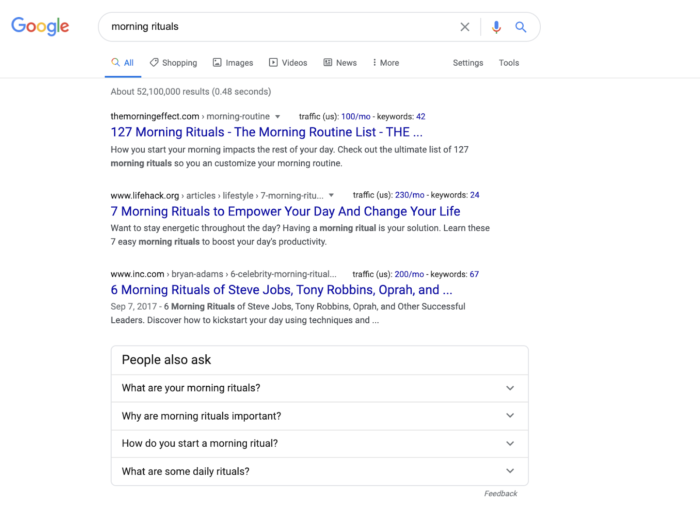
You click on the first result. But the page is hard to navigate, and the content’s not useful.
Within a few seconds, you hit back on your browser and click on the second result.
The second page has excellent content, and the website is easy to scroll through. You end up spending six minutes there and then go back to the SERP.
Now, if other people also spend more time on the second page, Google may factor that in their page rankings and demote the current first result. That will bump the #2 result up to #1.
Although Google hasn’t gone on the record to say dwell time is a ranking factor, the closest thing we’ve got so far is a Google engineer sharing this tidbit:
“So when search was invented… they wrote heuristics that had figure out what the relationship between a search and the best page for that search was. And those heuristics worked pretty well and continue to work pretty well.
But Google is now integrating machine learning into that process. So then training models on when someone clicks on a page and stays on that page, when they go back or when they and trying to figure out exactly on that relationship.”
Here’s another strong indicator that dwell time is at least a mild ranking factor: Google used to let you hide specific websites on the SERP after visiting them.
If you bounce fast from a page, you could block all results from a domain – because Google knew that if people left a page quickly, there was a good chance they didn’t like the content.
Over time, that feature was dropped, likely as Google better understood which sites were most useful.
Dwell Time Versus Time On Page
You may have heard of time on page, which is the amount of time a user is on a page until they go anywhere else.
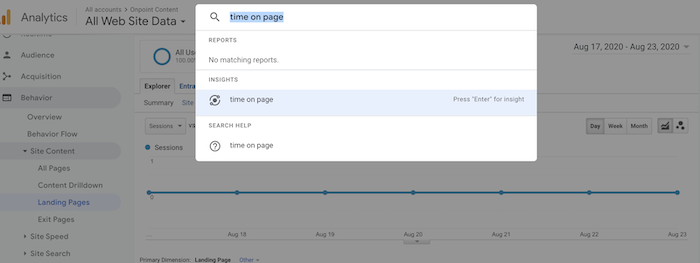
Time on page is based on two clicks:
1. A user visits your website.
2. The user then clicks on another page on your website.
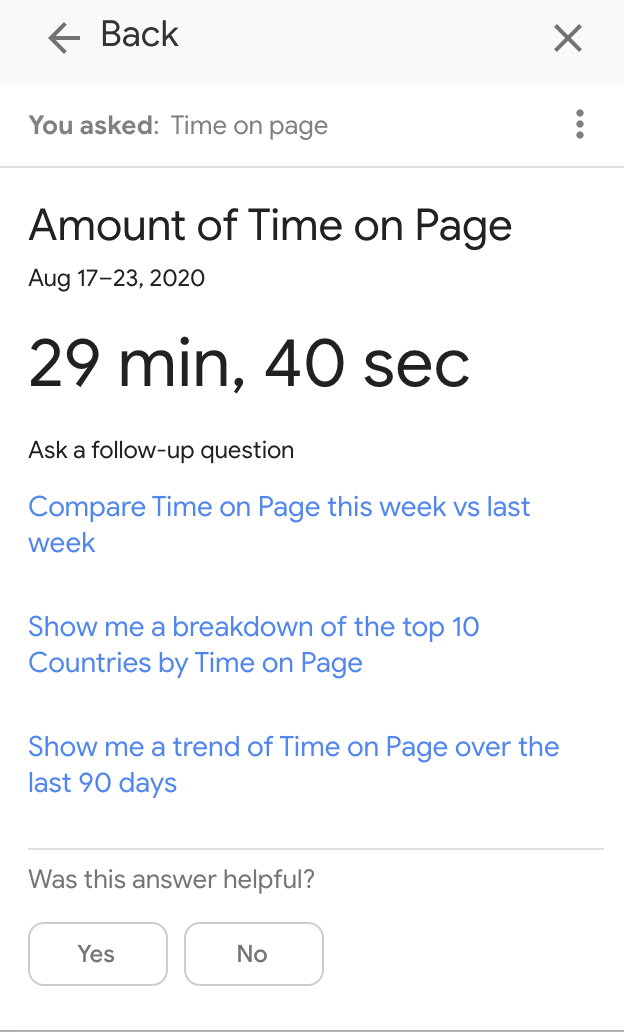
The big difference between time on page and dwell time is whether or not the visitor went to another page on your website. With time on page, they have to visit a second page on your website for Google Analytics to take the session into account.
If a user only visits one page on your website, Google Analytics shows time on page for the session as zero.
Here are 11 strategies to increase your pages’ dwell time.
Hook Readers In
You have one shot at making a great first impression from the SERP. One web usability study found the first 10 seconds of a page visit are critical for determining if a visitor stays or goes.
Are your blog post introductions reeling in readers? To encourage dwell time, each introduction needs to be interesting and relevant to your target keywords.
Take this example from a recent post about spying on your competitor’s SEO.
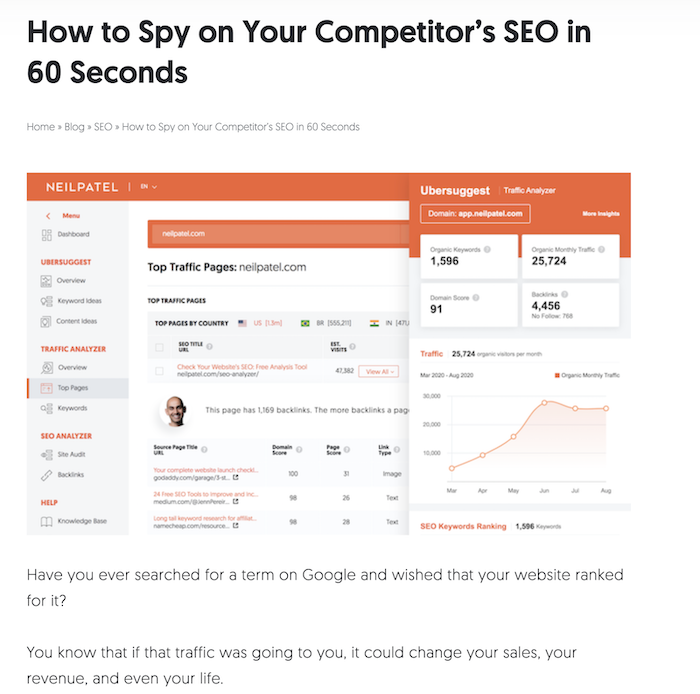
The open-ended question is the hook. The follow-up sentence is brief and touches on a universal pain point. It also acts as a transition guiding the reader to the thesis.
This hook isn’t like a traditional university paper thesis, though. It’s a teaser of what readers can expect in your article.
Divide Into Snackable Sections
Your introduction gets site visitors engaged and excited to continue reading.
Use H2’s to break content into sections, so it’s easy to read. It also makes it easier for folks to go back and reference your content later.
A good example is this article on defining your target audience.
Another way to make your content easier to consume is to turn succinct lists intobullet-pointt format. These make content easier to read and help users find the meat of the content faster.
Another way to engage readers is to use a ton of screenshots and other visuals to illustrate your points.
Create a Multimedia Experience
Infographics aren’t just great for referral traffic. Visuals can also help keep your site visitors engaged.
For example, check out this content layering infographic. It makes a complex topic easier to digest and understand.

Here are a few tools you can use to create visuals for your content quickly:
Video can also encourage visitors to stick around. 80% of marketers said in a Wyzowl survey video increased the dwell time on their website. Embedding videos in your content can too.
Here are a few different strategies to increase the effectiveness of video:
- Use an eye-catching video thumbnail so users will click and watch.
- Customer testimonial videos and product videos can be a powerful way to push conversions.
- Embed video explaining a specific strategy or concept you touch on within your content. Use the video for diving deeper into the strategy.
- Share a video from a popular YouTube channel in your content. Then reach out to the producers, as there may be opportunities for social referral traffic.
- Insert a video containing information with related content.
Match Search Intent
If you’re looking to rank #1 for a keyword on Google, you need to be the most relevant query. In other words, the content on your page needs to reflect a searcher’s intent, the reason for the search.
Let’s say you’re trying to rank for “best spa” in NYC.
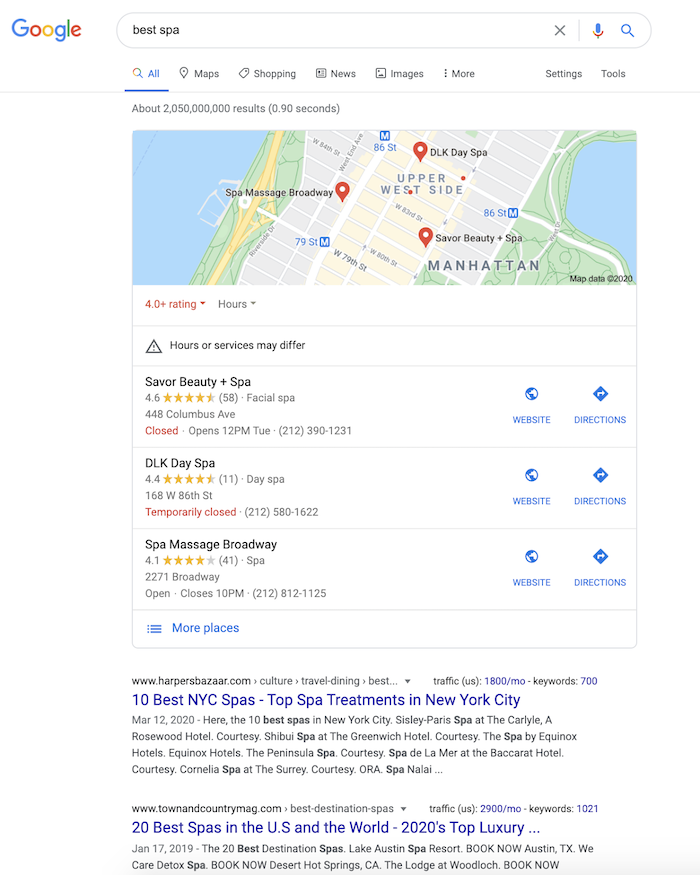
Google knows the most relevant results from millions of searchers who have either bounced or stuck around pages. In this case, spa options based on a searcher’s location and the best spas worldwide are the top results.
A landing page spotlighting a specific spa won’t work. However, charts showing different destination spa’s amenities and price comparison tools may be effective.
The four most common types of search intent are:
Information
A searcher is looking for general information (“How can I interpret my dreams?”) or an answer to a specific question (“How old is Elon Musk?”)
More examples of information searches:
- “When is NBA draft”
- “LAX Terminal 4 to 5 directions”
- “Howard Schultz”
Brand
The searcher is looking for a specific website or brand. They may forget the URL or find it easier to Google a brand than type out the site’s address.
Examples of brand searches:
- “Instagram login”
- “Ubersuggest”
- “Neil Patel guide to Local SEO”
Inquiry
With an inquiry search, a searcher shows interest in an item or solution but is still researching and comparing their options.
Examples of inquiry searches:
- “best spas”
- “United versus Delta”
- “Ubersuggest reviews”
Transaction
In a transaction search, the searcher is ready to buy. They are either looking for the best price or trying to find a specific item or service.
Examples of transaction searches:
- “Chipotles near me”
- “buy iPad pro”
- “athletic greens coupon”
Now let’s say a spa decides to target “corporate wellness retreats.” Here are the steps they can take to do competitive research on Ubersuggest:
First, review search volume and keyword difficulty under “Keyword Ideas.”
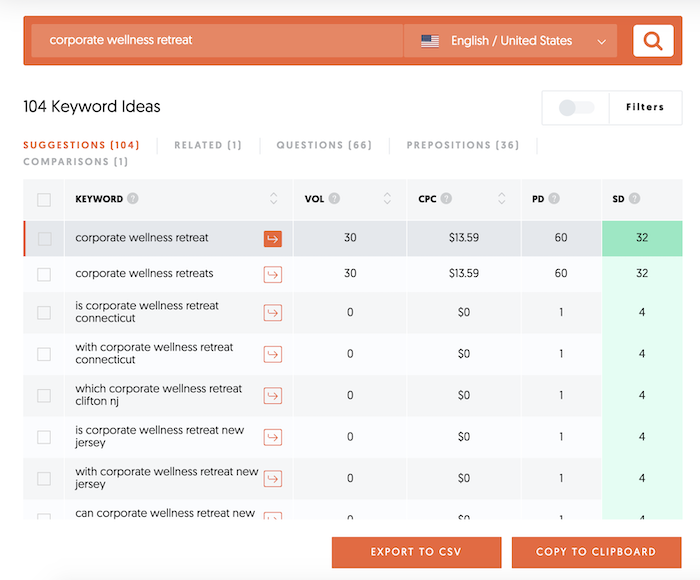
Next, analyze the top SERP results for that keyword.
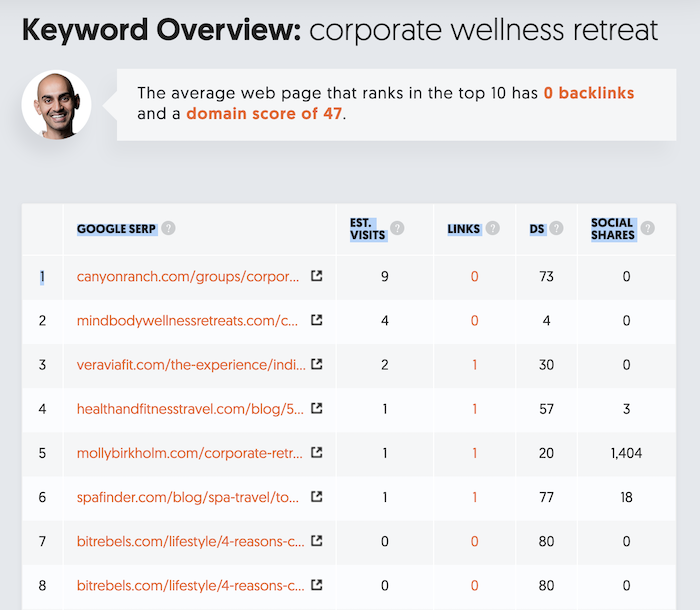
Are the top results product pages, blog posts, or another format? For a search of “corporate wellness retreat,” we can see most of the top 10 results are landing pages.
As you review each page, take notes on the page’s content to see how you can improve.
You can also review on-page optimizations, such as the use of keywords in headlines and subheadings and any other factors encouraging dwell time.
Then review the top results off-page SEO strategy. Copy the URL of any result into Ubersuggest and select overview to see more about the domain, including:
- The number of backlinks pointing to their domain
- Domain score; the higher the number, the more authoritative a site is, and the higher it will rank in Google
- The number of unique domains linking back to their domain

Craft In-depth Content
In most cases, longer content gets more traffic. Since it takes more time to read, more robust content boosts dwell time.
Help encourage visitors to stick around by providing the go-to resource for a specific query using the Skyscraper technique (a term initially coined by Brian Dean of Backlinko).
All skyscraper content has one or more of the following elements:
- Useful: Does it provide step-by-step instructions where possible? Are you providing your reader with clear takeaways?
- Entertaining: Does your content draw in your reader either through a compelling narrative, hook, or funny bits?
- User Experience: Is your content easy to navigate and skim? Does content logically flow? Is the content accessible in tone and style? In particular, it doesn’t read like a post-graduate paper or use larger words than needed.
Each of the eight steps in this article on monetizing your blog shows you don’t need a massive amount of traffic to start making money. Readers can also see a ton of examples where they can draw inspiration.
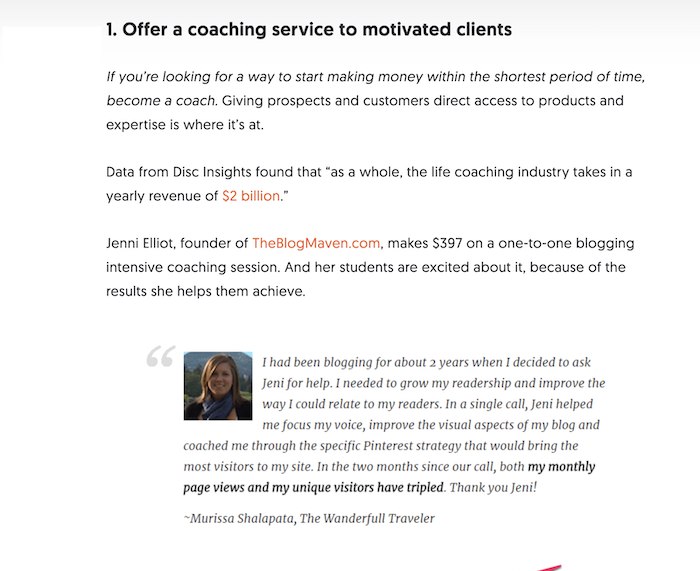
By creating thorough content it ranks #1 for highly competitive keywords and readers spend an average of over 4 minutes on the page.
Enable Comments
Open up your blog to questions and discussion in the comments. Just like here, where I try to reply to all comments.
People want to read others’ comments. Other readers likely have the same questions and can contain additional valuable responses from the author.
As people read or add in their own comments, their dwell time goes up.
Plus, you can get a ton of great feedback with your site visitors, like the comment below.

Create Interactive Elements
Interactive content not only keeps users on your page longer, it can also improve the user experience.
Quizzes, polls, downloadable assessments, and calculators are all features that can help site visitors work through the specific issue they came to your site to solve.
Establish Next Steps
If someone wants to learn more about a specific topic you’ve covered, make it easy to access with an internal link.
Internal links not only help keep users on your site, but are another key feature for on-page optimization.
Your internal links can also guide users to take the next step along your inbound funnel.
As you may know, a pillar page is a central piece on a website covering a topic in-depth.
Let’s say you’re looking to target a keyword with significant volume like “camper living.”

Once you create a pillar page targeting the keyword, you may develop a blog post reviewing an RV essential like a mobile hotspot. Then link to this piece on your pillar page.
Increase Your Site Speed
Part of making a great first impression — and preventing people from hitting the back button on your site — is ensuring your pages load fast.
47% of consumers expect a page to load in two seconds or less.
A few tools to help speed up your site:
Mobile First
More than half of worldwide traffic comes from mobile devices, which means you need to provide a mobile-first experience on your website.
What does that mean? Your site needs to perform well on mobile devices, not just desktop.
Here’s how you can double-check your pages are optimized for mobile:
- Visit Google Search Console.
- Click “Mobile Usability.”
- If any errors show in Search Console, click the error for details on how to fix the issue on your site.
Google’s support documentation that is linked in the results also provides more info on specific errors.
Level Up the Copy
You can have the best content but still fail to resonate with your readers.
Are all the sentences in your content the same length? Do paragraphs begin the same way? It will get boring.
Copywriting techniques are the ace up your sleeve. Here are a few strategies to keep your writing engaging you can take from copy masters:
Make it simple. Make it memorable. Make it inviting to look at. Make it fun to read.
-Leo Burnett
Can you say the same thing in fewer words? Are their compelling stories or statistics you can use to draw in a reader?
Copy is a direct conversation with the consumer.
– Shirley Polykoff
Keep the conversation going by mirroring your customers. Not sure what your audience is thinking? Survey your current and existing customers.
Have sections where readers may get overwhelmed or bored? Use Bucket Brigades, a term penned by Brian Dean. These phrases that help bridge two sentences and lead readers through content.
These phrases are instant attention grabbers and keep readers from bouncing:
- Pro-tip:
- Here’s the deal:
- Now:
- What’s the bottom line?
- You might be wondering:
- This is crazy:
- It gets better/worse:
- But here’s the kicker:
- Want to know the best part?
Conclusion
All of these techniques can help increase dwell time. But let your rankings and analytics reveal the most effective elements for your content. Start at the top of the list and try each strategy. For example, you might find that your users respond to interactive elements or that they prefer lists.
Once you see what works, you can fine-tune your strategy.
Which strategy will you try first?
The post 11 Proven Ways to Increase Dwell Time appeared first on Neil Patel.
from Blog – Neil Patel https://ift.tt/3c4Cgp2
via IFTTT
No comments:
Post a Comment